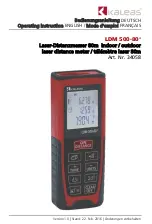
Important notes:
In general, "D" Connector numbering patterns are standardized. There are, how-
ever, some connectors with nonconforming patterns and the numbering sequence
on your mating connector may or may not coincide with the numbering sequence
shown in our pin configuration table above. It is imperative that you match the
appropriate wires in accordance with the correct sequence regardless of the par-
ticular numbers displayed on your mating connector.
Make sure power is OFF when connecting or disconnecting any cables in the system.
The (+) and (-) power inputs are each protected by a 750mA M (medium time-lag)
resettable fuse. If a shorting condition or polarity reversal occurs, the fuse will cut
power to the flow transducer circuit. Disconnect the power to the unit, remove the
faulty condition, and reconnect the power. The fuse will reset once the faulty con-
dition has been removed.
Cable length may not exceed 9.5 feet (3 meters).
Use of the FMA 1400/1500 flow transducer in a manner other than that specified
in this manual or in writing from Omega
7
, may impair the protection provided by
the equipment.
3.
PRINCIPLE OF OPERATION
The stream of gas entering the Mass Flow transducer is split by shunting a small
portion of the flow through a capillary stainless steel sensor tube. The remainder
of the gas flows through the primary flow conduit. The geometry of the primary con-
duit and the sensor tube are designed to ensure laminar flow in each branch.
According to principles of fluid dynamics the flow rates of a gas in the two laminar
flow conduits are proportional to one another. Therefore, the flow rates measured
in the sensor tube are directly proportional to the total flow through the transducer.
In order to sense the flow in the sensor tube, heat flux is introduced at two sec-
tions of the sensor tube by means of precision wound heater-sensor coils. Heat is
transferred through the thin wall of the sensor tube to the gas flowing inside. As
gas flow takes place heat is carried by the gas stream from the upstream coil to
the downstream coil windings. The resultant temperature dependent resistance
differential is detected by the electronic control circuit. The measured gradient at
the sensor windings is linearly proportional to the instantaneous rate of flow tak-
ing place.
An output signal is generated that is a function of the amount of heat carried by
the gases to indicate mass-molecular based flow rates.
Additionally, FMA 1400 model Mass Flow Controllers incorporate a proportionat-
ing solenoid valve. The closed loop control circuit of the FMA 1400 continuously
compares the mass flow output with the selected flow rate. Deviations from the set
point are corrected by compensating valve adjustments, thus maintaining the
desired flow parameters.
4
Содержание FMA 1500
Страница 37: ...NOTES 32...
Страница 38: ...NOTES 33...










































